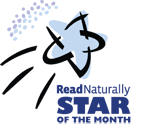Dyslexia is a reading disability that affects millions of Americans. If identified early and treated with effective intervention, however, it does not need to adversely affect the lives of children with dyslexia.
Read more Dyslexia exists in all cultures and all languages. However, it does not impact learners in every culture in equal measure; the severity of dyslexia’s impact partially depends on the language a person is learning to read.
Read more In recognition of Dyslexia Awareness Month, Read Naturally begins a series of articles designed to build knowledge around the learning disorder of dyslexia. This first article summarizes the remarkable discovery of the language disorder over 140 years ago.
Read more Dyslexia is one of the main challenges we address here at Read Naturally. For dyslexia awareness month, we want to point you toward the myriad ways in which a Read Naturally intervention can help students with this learning difference.
Read more Your struggling readers have likely asked themselves, or you, “Why is reading hard for me?” Sometimes, there is not a clear reason. With a little extra help, many struggling readers are simply able to crack the code and catch up. Other times, there is a clear reason: For millions of students, it’s dyslexia. Unfortunately, many individuals with dyslexia remain undiagnosed and have a more difficult time catching up to their peers.
Read more America has been celebrating Disability Pride Month every July ever since passing the Americans with Disabilities Act (ADA) on July 26, 1990. Recognizing and celebrating individuals with disabilities should be an everyday, every-month practice, but we appreciate having a calendar month dedicated to this work—especially since helping students with disabilities and learning differences is a big part of what we do here at Read Naturally.
Read more To advance literacy worldwide over the next decade, what topics do educators need to focus on? The International Literacy Association (ILA) recently put this question out to 1,443 literacy professionals from 65 countries and territories in the 2020 What’s Hot in Literacy survey. With the ultimate goal of better outcomes for students, this reputable report highlights the most critical topics in literacy and identifies areas that need more support.
Read more After a challenge is identified, one of two things tends to happen: either the challenge grows, or it shrinks. The challenge tends to grow if the solution is unknown and hard to find. Conversely, it tends to shrink if there is a tried-and-true, high-quality solution at the ready. As you know, struggling readers fare best if there’s a clear and effective way to help them move forward. For thousands of schools, that way forward is Read Naturally.
Read more If you work with struggling readers, chances are you’ve encountered a student with dyslexia. Dyslexia is the most common learning disability in the country. Students with dyslexia are smart and competent, but differences in their brains make reading much harder for them. While educators and parents don’t usually make official dyslexia diagnoses, they are often the first ones to spot the symptoms, which include trouble with decoding, spelling, rhyming, and phonological awareness.
Read more Children are masters at reading our expectations of them. What we communicate with our body language, mood, and tone of voice while interacting with them often speaks louder than the actual words we say. And when we have expectations, guess what? For better or worse, the children live into them.
Read more  Share your student’s success story—nominate him or her for our Star of the Month award. Win a Barnes & Noble gift card for the student and a Read Naturally gift certificate for your class!
Share your student’s success story—nominate him or her for our Star of the Month award. Win a Barnes & Noble gift card for the student and a Read Naturally gift certificate for your class!